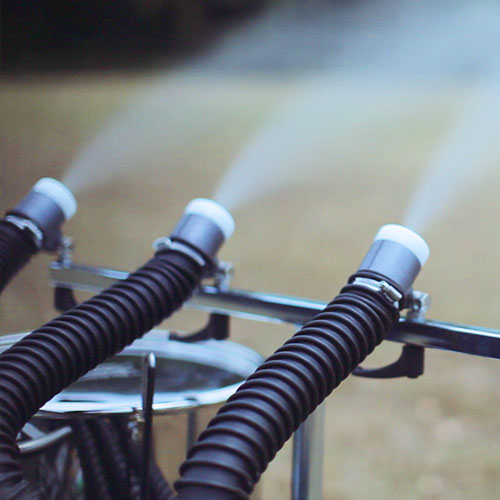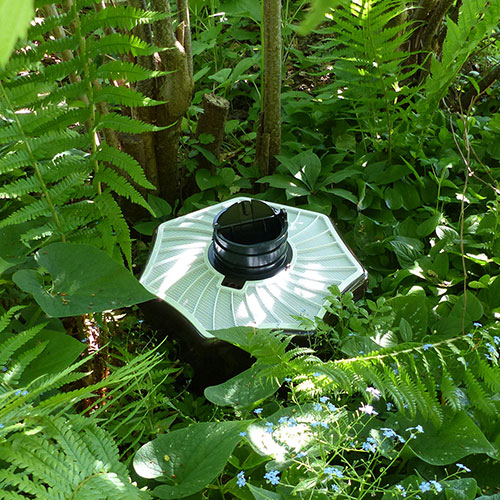PEST CONTROL
PEST CONTROL
If the damage occurs at stored corn, it is called storage pest. If the pest damages cables, it is called stock pest and if it distributes diseases, we talk about health pest.
Insects that damage stock are crawling insects, moths and mites, which damage stored foods and animal feed in quality and quantity, either by grub or contamination by frass, larvae skin or remains of crawling insects. It is important not to underestimate a possible contamination with pathogenic germs. Another problem is that most stock pests are cosmopolites and extraordinary heterophagous, i.e. little choosy.
Furthermore, health damage caused by pests is not limited to epidemics and diseases, but comprises just as well stitches, allergies, eczema, nauseation etc.!If the damage occurs at stored corn, it is called storage pest. If the pest damages cables, it is called stock pest and if it distributes diseases, we talk about health pest.

ACTIVE AGENTS
In the course of the time a large number of insecticides with specific characteristics have been developed. These active agents differ essentially through:
- Ability of decontamination
- Chemical group affiliation
- Compatibility to materials
- Economical obligations (registration costs/quantity/attainable price)
- Evaporation
- Flushing
- Knock-Down-Effect
- Long-term effect
- Metabolism
- Mode of action and/or impact on the target
- Resistance potential
- Smell
- Specific effect
To achieve a specific target, these topics have to be considered towards each other carefully and the national and/or international laws and regulations, which regulate completely almost all ranges of pest control, must be kept.
BTI – Bacillus Thuringiensis Israelienis
BTI is a biogenous insecticide. This biological preparation is bred millionfold and can be manufactured in the laboratory. BTI is a well established active agent against mosquitoes and highly effective. It is applied into the water living environment of the mosquito larvae. Anopheles larvae take up BTI through food intake to their body. BTI damages the digestive tract of the larvae. Thereby the food intake of the larvae is interrupted and it will die in the larva stage. BTI is available as liquid, powder, granules and tablets.
TYPES OF FORMULATIONS
Encapsulated pesticides / cap suspensions (CS) – The active ingredient is contained in an extremely small capsule. The capsules are suspended in a liquid. This formulation is mixed with water. The active ingredient is released controlled and slowly.
Emulsions (EW) – organic solvents are replaced totally or partly by water. Stable aqueous emulsions of water-insoluble organic pesticides are formed by mixing the pesticide with an aqueous dispersion.
Emulsive concentrates (EC) – are liquid formulations in which the active ingredient has been dissolved in oil or other solvents and an emulsifier has been added so that the formulation can be mixed with water or oil.
Solutions and water soluble concentrates (S) – are liquids in their original state and are completely soluble in water or other organic solvents.
ULV concentrates – High concentrate liquids may be thought of as special EC formulations. They usually contain high concentration of active ingredient. Most are made to be mixed with water or oil. ULV concentrates are made to be used directly without dilution.
Water-disperse-granulates (WG) – dry particles, which are processed to granulates. These are flowable. Contrary to wettable powders, granulates have a high part of dispersing agents to ensure a fine distribution when poured into water.
Wettable powder (WP) – are dry powdered pesticide formulations. They contain wetting and dispersing agents. The formulation does not form true solution. Thus agitation is required in the solution tank to keep the formulation in suspension.

METHODS TO COMBAT PESTS
The choice of specified methods to combat pests complies with art of pest, size of location, usage of location and area of distribution. There are two ways to combat pests: the active or the passive method. Basically, one could say: the more selective biocides are applied, the lower the quantity of pesticide and the lower probable stress for human beings, animals and the environment.
You achieve a visible result fast by applying the active method, e.g. when the biocide is brought directly to the pest by fogging, spraying or misting. The passive method aims at a longer lasting impact. As the insect has to come up to the pesticide, e.g. surface covering, gritting, trap or bait, it takes a while to show results.
To take advantage of both methods of application, they can be combined. For example, one can spray a barrier with a long durable biocide and fogs an agent with shoot effect (e.g. pyrethrum) afterwards.
More than ever in pest control, the society poses the question of being recognized as safe. The optimal adaptation of the highest possible use and lowest possible risk keeps posing a challenge, which we meet with profitable innovations.
Pest Control in Large Locations
To not constrain operation procedures and to avoid high costs by loss of production, pest control in big locations of companies can often only be applied outside normal working hours or at week-ends. Even then, there are only a few hours time left and, therefore, a particularly effective and easy manageable technique is needed: the fogging technique.

ULV COLD FOGGERS IN PEST CONTROL
Fast reproduction of pests requires instant action. Only if the combat occurs before the copulation and/or oviposition of the according species, it is possible to break the life circle of the insect and eliminate effectively the spread. To prevent new settling, it is indispensable to apply the agent right into the smallest hideouts of hidden insects.
Here, applying minute droplets in the ULV technique is particularly appropriate. With our special ULV aerosol generators, the active agent is break up in to aerosols. The droplets of the aerosols are smaller than 50 micrometers (to compare: a human hair adds up to approx. 100 micrometers). The degree of sputtering is of vital importance. Each fog is polydispers, which means, it consists of particles of different size. In the ULV process, the spectrum of droplets is relatively narrow. With IGEBA ULV Aerosol Generators 90 % of all droplets are lower 27,9 microns at an output rate of 10 l/h through one nozzle (water) and lower 36,4 microns at an output rate of 20 l/h through two nozzles (water). Common sprayers can produce doplets of approx. 600 micrometers.
In practice, 1 gram of the insecticide “Detmolin” (808-biocide, Frowein GmbH und Co. KG) generates more than 250 million aerosol particles Therefore, billions of insecticidal nebulous droplets flow into the room per second, which are distributed through the strong airflow and penetrate deeply even into all cracks, where insects could stay.
The ultra-fine droplets stay airborne and enable the absorption of the active agent by the insects – either by contact or, as with Dichlorvos, by respiration. Because of the high steam pressure already during the fogging, Dichlorvos is transformed into gas, and the insects to reabsorb it by respiration.
The effort of the ULV process is low. Before the application, windows, doors etc. have to be closed as well as the air conditioning unit and ventilation ducts have to be switched off. Fogging is carried out from one place or mobile, according to local circumstances and product. In doing so, the most affected areas can be treated at short distance. After 4-6 hours, the rooms can be ventilated; air con and ventilation systems can be switched on again.
Please observe the product information and the dosage corresponding to the terms of approval by national/international legislation when applying agents. The specifications correspond to the maximum dose that guarantees even in adverse conditions the intended combat success. Depending on the species of pest, its age, stage, number, spreading, type of room, usage, constitution, climate of location, frequency of measures etc., we can tell from experience, that even considerably smaller amounts of the agent is sufficient.

EFFECTIVE EMPLOYMENT OF FOG GENERATORS IN VECTOR CONTROL
Thermal fog generators are preferably used to control flying vectors, i.e. adult mosquitoes. Thereby the application of environmentally friendly technique in vector control gains more and more in importance in view of present environment problems. With smallest application rate per area, IGEBA fogging technique contributes to avoid environmental damage.
IGEBA thermal fog generators can be used indoors as well as outdoors to produce a dense insecticidal fog, which causes with the correct insecticide an instant effect (knock-down-effect) and kills both flying and crawling insects. In appropriate weather conditions, the fog passes through an affected area outdoors in a very short time. Due to the little application rate, environmental stress is minimized, without influencing the high efficacy of the applied insecticide.
The extremely high number of small droplets created by thermal fogging generates a dense and visible fog (using an oil based formulation), which facilitates the observation and thoroughness of treatment.
In vector control, portable fog generators and also fog generators mounted on vehicles are used. Thermal fog generators mounted on vehicles are preferably equipped with remote control for that the unit can be steered from the driver’s cabin, which, therefore, eases the application considerably. Taking the wind direction and wind force into account – as well as the driving speed, the treated area is covered with fog to antagonize effectively flying insects without residue.
Portable thermal fog generators are often used to enable better individual treatment, respectively at places where access possibilities for vehicles are limited. Also, portable thermal fog generators are used indoors. IGEBA AF-34 is a fog generator especially designed for this purpose.
This method is not only capable to control flying vectors by contact with droplets, but it is also applied with the appropriate insecticide to gain an effective flushing effect.
Space spray has become popular to control urban vectors mosquitoes and does not have residual effect. It is very common in emergency cases. Fogging helps do bring down the infectious mosquito population.

 CHEMICALS
CHEMICALS